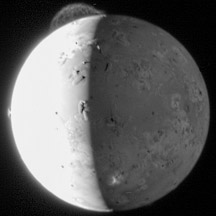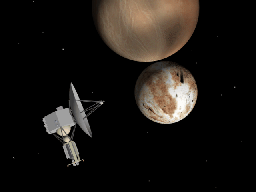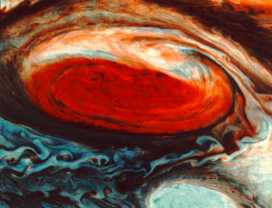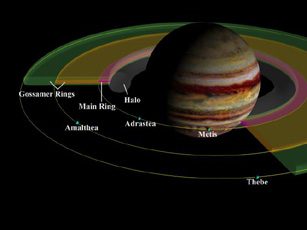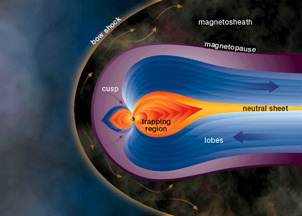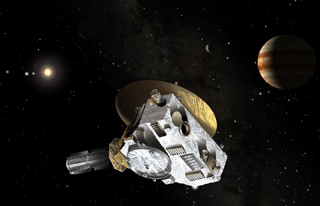Click on image for full size
Image courtesy of NASA/Johns Hopkins University Applied Physics Laboratory/Southwest Research Institute.
Results from the New Horizons Jupiter Flyby
The New Horizons spacecraft is on its way to Pluto. Along the way, it flew past the giant planet Jupiter. When the spacecraft flew by Jupiter, Jupiter's strong gravity gave New Horizons a "slingshot boost" in speed. The boost added 4 km/sec (9,000 mph) to the spacecraft's speed. That's quite a boost! The extra speed will make New Horizon's trip to Pluto take less time. Still, the spacecraft won't reach Pluto until 2015!
New Horizons blasted off in January 2006. It flew by Jupiter on February 28, 2007. It was going about 21 km/sec (47,000 mph) when it zoomed past Jupiter! But Pluto is very far away. Even at these high speeds, it will take New Horizons about nine years to go from Earth to Pluto.
Scientists took some great new pictures of Jupiter and gather other data when New Horizons flew past the planet. The spacecraft has very good cameras and other instruments on board.
The New Horizons team also got to practice a planetary flyby. When a spacecraft flies past a planet, it needs to make a lot of complicated moves. It needs to point its cameras the right way. It needs to turn instruments on and off at the right times. And it needs to radio the data it collects back to Earth. The New Horizons team got to practice all of this when the spacecraft flew past Jupiter. Then they will be ready when New Horizons finally makes it to Pluto!
New Horizons took many great pictures of clouds in Jupiter's atmosphere. It also gave scientists their first good look at the "Little Red Spot". The Little Red Spot is the "smaller cousin" of Jupiter's famous Great Red Spot. The Little Red Spot formed over the last several years when three smaller storms merged together .
New Horizons also got some nice pictures of Jupiter's rings. The spacecraft isn't finished studying Jupiter yet. It will make measurements of the giant planet's magnetic field for weeks after the flyby. New Horizons will be in Jupiter's magnetotail for several weeks after the flyby. The magnetotail is part of Jupiter's magnetosphere.
New Horizons also took pictures of a few of Jupiter's many moons. It took pictures of the icy surfaces of Europa and Ganymede. It also got some of the best shots ever of volcanic eruptions on Io.


